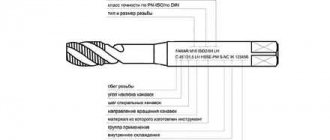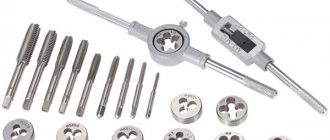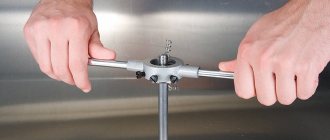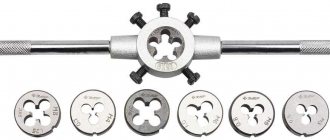How to restore a broken thread in a cylinder head?
Oddly enough, quite a lot of people make a tragedy out of this, thinking that the head (or block) needs to be drilled out, special pins selected, and the like. In fact, threaded connections or cracks that do not bear the main load of the piston system are very easy to repair.
My head was no exception in this matter. Its previous owner twisted all the bolts in it with all his heart, as a result of which I precisely replaced 4 bolts on the yokes with studs. and somehow they turned another bolt for me. I had to do it myself. Fortunately, I see such surprises quite often. You can easily deal with them using a special epoxy designed for metal and high temperatures. This time I got my hands on this Manolov one.
This is done simply: Take a long screw. I have such a tool for this case. And we take some more cotton wool. We make a turund like this and soak the oil out of the hole.
Then, making more and more turundas, soaking them in solvent, degreasing the hole and wiping it dry. We also degrease and wipe the bolt.
Then we work quickly. We dilute a little resin and hardener in equal proportions, quickly mix the whole thing, and apply it to the thread. It is advisable to do all this within a minute, because... the composition hardens quite quickly.
IMPORTANT
: There is no need to coat the entire thread with resin.
It is necessary to leave 4-5 turns on the tip of the bolt
.
At the end of the thread, you should also not smear it too much, because... the resin will still begin to displace. BUT
: if you screw
a pin
and not a bolt, then it is better to coat it entirely, because Once it hardens, you no longer need to rotate it.
We tighten the bolt (stud) by hand until the end, but without any effort
, and let's go to bed))) Resins usually completely polymerize after a day. After 20 -24 hours, these connections can already be tightened to the nominal torque.
Of course, all this is done in a good mood and to cheerful music!
Just don’t try to repair in this way the spark plug threads, or the threads of the bolts that press the cylinder head to the block, as well as those places that are in direct contact with the combustion chamber. Here it is better to make appropriate pins or screws. In other cases, this method can be safely used. Tested by time.
First of all, a huge thank you to Matvey palodin!
So, after the thread was torn off and I twitched for some time in convulsions, it was decided to order a thread restoration kit from Moscow www.mactak.ru/store/nabor…vleniya-rezbi-volkel-4021 for 2535 rubles, the price tag is humane, but further - this is something.
Read also: Will paint adhere to a varnished surface?
More precisely, sending it to Kazakhstan by the transport company KIT was like the circles of hell. They demanded a shitload of paperwork from the store to process the shipment from a legal entity to an individual, supposedly all sorts of customs documents and clearances. And this is in the customs union, blah. As a result, after about three weeks, I gave up on KIT (which I had been using for three years) and the hemorrhoids they created and asked the manager to send me SDEK, which completed the task in 4 days, their delivery price was worth it (quite a little more expensive than KIT)! Honestly, during the attempt to send through KIT, I had cramps from the broken thread not only did not stop, but they intensified, winter is coming, snow is coming, and the car has been waiting for a small parcel for two months, despite the fact that the repairs began in the summer. So KIT has a huge karmic disadvantage.
Anyway, my package arrived, the sun was shining outside, Indian summer was in full swing, and I started cutting the threads. And here, my friends, I would like to immediately save you from some mistakes. Be sure to cover the block with masking tape, because there will be a lot of shavings; use lard for the tap. If you have a thread like ours - it starts somewhere deep (in some engines the thread starts flush with the plane, in a Volvo it starts deep inside), use a special tool for screwing in the inserts, you don’t need to use the tool from the kit. There is a special retaining ring, which was not invented in vain. Otherwise it will be very painful and offensive.
Either take a special tool for installing the insert in deep wells or make one from an old bolt according to a sample.
The whole procedure is carried out very quickly, for example, after the first restored thread, during assembly, an adjacent bolt was torn off. So, I restored the second bolt in about 2 hours, with the hole cleared of chips. I tightened it using the standard torques according to the manual, everything was ok. I’ve been driving for the second week (350 km), everything is also ok. I recommend this method for several reasons. Firstly, with this set you cut M14, and the screw from the turner will be the following size - M16. Those. This way you save one repair size. The threaded inserts themselves cost about 50-100 rubles per piece, which is much cheaper than turning screws (one screw will cost me 200 rubles, plus a set of M16 taps for about 1000 rubles + xs drill = this set is almost cheaper). The repair technology is extremely simple.
Threaded hole repair (restoring damaged threads)
Our company does not restore threads. This article is intended solely to introduce you to the thread restoration process. In our stores you can buy fittings (threaded inserts), drills, taps, thread restoration kits.
The information is intended for persons carrying out repairs in a personal garage and car repair shops. In accordance with this, the text is structured and recommendations are given. The use of this method in manufacturing enterprises involves the use of specific tools and devices, and other technology.
Thread restoration method
Damaged threads can be completely restored using the following technology:
1. Drill the threaded hole to the diameter indicated in the table below 2. special profile thread in it Screw a spiral repair insert (a durable stainless steel sleeve) into the resulting thread using a special tool.
Threaded insert
After such an operation, the thread becomes stronger than the original one in good condition. This effect is especially noticeable when the carving is made in a soft material such as aluminum. When a bolt (stud) breaks off in a threaded insert, there is no “biting” effect. A broken bolt (stud) can be easily removed.
Watch a video of how the threaded insert is used
What capabilities do threaded inserts have?
This method is especially relevant for restoring threaded holes in body parts of automobile engines, for example, a spark plug hole. The candle thread becomes very durable and reliable.
Threaded insert is screwed in Threaded insert is screwed in
If the thread for a stud is broken, sometimes they drill it out and cut the thread to the next size. In this case, you have to use a stepped stud of unknown origin and dubious quality. And not every stepped hairpin can be found at the right time. If you repair the hole using a threaded insert, you still have the option of using a standard, branded pin.
Another application for repair threaded inserts is in brass exhaust manifold nuts. The result is a nut that combines a very strong thread and the property of not “sticking” to the studs.
Owners of some foreign cars should pay attention to the possibility of replacing the M12 x 1.5 thread with an M12 x 1.25 thread. It often happens that a bolt with such a thread is damaged, and it is almost impossible to find it in a retail chain in your city (we have such bolts in our store). A turner will not turn out a decent bolt, because... The threads on factory bolts are formed by pressure (knurling), which provides the necessary strength. And on a lathe, the thread is made with a cutter, while the fibers of the steel bar are cut and the threads cannot bear the required load.
If you replace the thread in the body part with the more common in Russia M12 x 1.25, it becomes possible to select a bolt of the required size and strength from the assortment of Russian and European manufacturers of automotive fasteners presented in our catalog.
Video - how a threaded insert works, demonstration
What tools are used to restore threads?
| No. | Repairable thread sizes | Drill diameter |
| 1 | M5 x 0.8 | 5,2 |
| 2 | M6 x 1 | 6,3 |
| 3 | M8 x 1 | 8,3 |
| 4 | M8 x 1.25 | 8,4 |
| 5 | M10 x 1 | 10,25 |
| 6 | M10 x 1.25 | 10,4 |
| 7 | M10 x 1.5 | 10,5 |
| 8 | M12 x 1.25 | 12,25 |
| 9 | M12 x 1.5 | 12,5 |
| 10 | M12 x 1.75 | 12,5 |
| 11 | M14 x 2 | 14,5 |
| 12 | M14 x 1.5 | 14,5 |
| 13 | M14 x 1.25 (for a candle) | 14,25 |
To repair the spark plug hole, a stepped tap is recommended. It is centered in the old hole with its lead-in part, and immediately cuts a new thread, bypassing the drilling operation.
A stepped tap significantly reduces the risk of damage to the spark plug hole, but it is noticeably more expensive than a regular tap.
To lengthen the tap when repairing a deeply recessed spark plug hole, you can use a regular 10-point twelve-sided socket with the appropriate tool.
3.
Spindle (tool for screwing in the insert)
The working part of the spindle is similar to the threaded part of a bolt, with a hook at the end.
4.
Repair insert
The insert is a spiral of a diamond-shaped profile.
At one end there is a leash, behind which the insert is rotated by a spindle. The inserts have different lengths.
Description of thread restoration technology
Attention: this technology is used for repairing threaded holes in domestic and garage conditions.
1. Drill a hole. Periodically remove the drill from the hole and dip its end into a container of motor oil. A minimum drill speed is desirable. 2. Use a tap to cut the thread for the insert. During operation, it is necessary to constantly supply motor oil to the cutting zone, for example from a medical syringe, especially when working with aluminum. Otherwise, the thread may turn out to be “torn”, rough, and aluminum will stick to the tap. If the hole is blind, it is better to use a lubricant, such as Litol, instead of engine oil. You need to coat the working part of the tap with it so that the chips do not fall into the hole, but stick to the tap. 3. Rinse the resulting thread with kerosene. 4. Place the insert on the spindle, engage the driver and the hook.
You need to keep in mind that the insert is slightly larger than the spindle; it does not sit tightly on it, but dangles freely. When screwed into the hole, the insert is compressed and thereby secured in the hole. Screw the insert until its rear end is 1/4 of the thread pitch deep into the hole. After this, unscrew the spindle and break off the insert driver by pressing on it with a suitable rod. To do this, there is a risk on the turn behind the leash, along which the leash will break off. Note: When using a stepped tap, point 1 is excluded.
Our company does not restore threads. This article is intended solely to introduce you to the thread restoration process. In our stores you can buy fittings (threaded inserts), drills, taps, thread restoration kits.
How to restore a broken internal thread?
No one is immune from the fact that when repairing a car or in other work situations, damage to a threaded connection may occur.
How to restore functionality to a seemingly faulty thread? Many craftsmen use the traditional method, the essence of which boils down to drilling a hole with a drill of a larger diameter and cutting a new thread with a tap.
However, after such a repair, you will have to use a counter element (bolt, pin, spark plug) of a larger diameter, which is not always possible.
This method will not work if the supply of “body” for drilling is insufficient.
How to repair a threaded hole while maintaining its original diameter?
Currently, a simple and reliable way to restore threads has been found, which has been used all over the world for quite a long time. In our country, unfortunately, it is slowly gaining popularity, both due to our ignorance and the inability to purchase special spring inserts and auxiliary installation tools in stores.
Many well-known manufacturers are engaged in the development and production of inserts. Products from different companies may vary slightly in name (screws, fittings), design and material, but the principle of operation and installation technology are the same for all.
On sale you can find not only sets of screws of various lengths, diameters and thread pitches, but also entire kits for restoring threads, which, in addition to inserts, include drills, taps, an installation device and a mandrel for breaking off the mounting lead.
Such solutions are offered by the German manufacturer of metal-cutting tools Volkel and the Russian Delo Tekhniki. Some brands call this technology and tool a “system”, for example:
- V-coil system
- Recoil system
- HeliCoil system
Types of spring threaded inserts
Wire inserts for repairing threaded holes have the shape of an elastic spiral, the turns of which form a high-precision rhombic profile on the inside, which is similar to the thread profile.
Most sold screws have a driving tongue that serves to screw them into the prepared receiving thread. After installation, it is easily separated along the cut using a special breaker.
Spring sleeves have a different number of turns and, accordingly, different lengths, which are designated 1d, 1.5d, 2d, etc., where d is the diameter of the spiral.
Special types of inserts are also available, for example, for spark plug threads or oxygen sensors.
Threaded inserts are made from particularly strong, high-quality steel, mostly stainless steel, which makes it possible to obtain reliable threads that are resistant to wear, deformation and corrosion.
Replacing damaged threads in four easy steps
The method under consideration allows, in a garage, without special skills, to repair a worn threaded hole in body parts made of steel and non-ferrous metals in four simple steps.
Step 1 - Drilling
Removing old threads using a drill. To select the drill diameter, manufacturers suggest using a special table that indicates the most common sizes of threaded holes to be restored and the recommended drill diameter.
Step 2 – Forming the Thread
The drilled hole is threaded using a special tap offered by the manufacturer, which has some differences from the standard thread-cutting tap. To work with spark plug holes, it is recommended to use a stepped tap, which allows you to bypass the drilling process.
Step 3 - Screwing in the insert
Installation of the spring bushing into the resulting thread is carried out with an installation device (spindle with a hook) included in the kit.
Step 4 - Removing the Installation Tab
After unscrewing the spindle, it is necessary to break off and remove the tongue on the spiral insert. This is not difficult to do thanks to the notch on the last turn and the specially provided tool.
Advantages of using repair inserts
The threaded insert has a rigid fit without gaps in the manufactured thread, eliminating the risk of unscrewing under dynamic loads.
This is achieved due to its spring properties and the slight difference in the diameter of the insert and the diameter of the thread in the hole.
The tension-tightened spring sleeve occupies a stable position without additional fixation with glue and ensures uniform distribution of the force from the bolt along the entire length of the hole.
This method allows you to form a thread that is not inferior in strength and reliability to the original one, and in cases with low-strength metals, it increases the load-bearing capacity of the thread. The durable steel from which the screws are made reduces the risk of rapid wear of the threaded surface during frequent tightening and unscrewing of fasteners.
The described system makes it possible to create reliable steel threads in soft materials (wood, plastic), as well as to make threaded connections in fragile and thin-walled parts. Using threaded inserts, you can easily transition from one type of thread to another, for example: from left to right, from metric to inch, from small to large and vice versa.
The use of spring inserts opens up new design possibilities and gives freedom in choosing the material and size of fasteners. The ability to quickly repair a threaded hole eliminates the need to replace an expensive part. If necessary, the repair inserts can be dismantled using the same tools included in the “system”.
Useful tips 03/19/2018 11:03:39
How to restore threads in an aluminum engine block?
The threads of the spark plug well are stripped while replacing the spark plugs. One or several candles are unscrewed along with the thread. Therefore, it will not be possible to install a new spark plug without repairing the thread.
If the breakdown occurs at a car service center, the car owner will be offered prompt repairs, which will be performed using a special tool for restoring threads.
If the thread is torn off in the field - in a garage or on the street, then the car will no longer be able to get to the nearest car service center. We advise you to find a service that has a special tool in its arsenal and agree with its employees about on-site repairs.
A tool for restoring candle threads does not require special skills to work with it. Therefore, you can carry out the repair yourself.
Often the thread breaks due to the spark plug being overtightened when screwed in. A breakdown occurs if the spark plug was replaced by an unqualified car service employee or an inexperienced car owner.
Also, the thread can be torn off due to the spark plug being skewed when screwing in. This happens if the wrong tool was used to replace the spark plug.
In addition, replacing spark plugs on a warm engine can also lead to damage. Therefore, carry out repairs only on a cold engine.
To avoid overtightening or distortion of the spark plug, it is necessary to use professional spark plug heads and a torque wrench to control the tightening torque.
There are two ways to restore the spark plug hole thread:
- Remove the cylinder head. Drill out a spark plug hole, cut a larger thread, turn out special fittings for it, etc.;
- Without dismantling the cylinder head. Restore the spark plug thread using a special tool.
How to restore a thread with a tap while maintaining its diameter and location
If you need to restore the thread while maintaining its diameter, use one of the following methods.
Welding the hole and then cutting a new thread
This method is rarely used due to the fact that the strength of the new thread obtained using this technology will be lower. This method is also chosen in the absence of special devices (screws and spiral inserts).
This method of thread restoration includes the following steps.
Removing old threads by drilling.
Welding the hole. The choice of technologies depends on the materials of the parts.
To weld holes in steel products, electric arc or gas welding is used in protective environments.
When working with cast iron parts, gas or electric arc welding is used in a cold state or with general/local heating.
Electrodes (MNCh-1, OZCh-1, TsCh-1), cast iron rods with a high silicon content and other materials are used as additives.
Machining the hole flush with the base metal.
Cutting a new thread.
Note! When working with aluminum products, this method of thread restoration is usually not used. This is due to the fact that the metal actively absorbs gases during welding. Pores form in the deposited layers. With severe shrinkage, cracks appear.
Restoring threads using a screwdriver
Screwdrivers are special cylindrical devices that have threads of the required diameter and pitch on the inside and large threads on the outside. Such products are made from steel, brass, bronze, copper and other materials. At the final stages of production, the screws are hardened and further strengthened.
Photo No. 2: screwdriver for thread restoration
If you need to restore the thread while maintaining the diameter using a screwdriver, proceed as follows.
Drill out the hole. The drill must be selected in such a way that the diameter of the resulting hole allows cutting a thread for screwing in the screw.
Cut the thread with a tap. Follow the rules listed above.
Screw in the screwdriver. It needs to be installed flush. If this is not possible, mill the part and remove the protruding part of the fixture.
At the border of the new thread and the screw, apply notches using a core. This will prevent the device from unscrewing spontaneously.
Repairing threads using a spiral insert
Spiral (also called wire and spring) inserts are also often used to restore damaged threads.
Photo No. 3: spiral inserts for thread restoration
These devices have high-precision rhombic threaded profiles on the inside. Almost all models are equipped with special driving tongues designed for screwing in devices.
For the manufacture of such products, especially durable high-quality stainless steel is used. This guarantees the resistance of the restored thread to deformation and corrosion.
Restoring threads using a spiral insert includes 4 stages.
Drilling. Drill out the hole. Select the diameter of the cutting tool according to the table that manufacturers provide with spiral inserts.
Image #1: Drilling the hole for the spiral insert
Thread formation. Note! To cut threads, use special taps that differ from standard ones and come with spiral inserts. Follow all rules and recommendations.
Image #2: Forming a thread for a spiral insert
Installation of the device. Place the spiral insert onto the supplied special tool and screw it into the hole.
Image #3: screwing the spiral insert into the hole
Removing the drive tongue. You can get rid of it using a special tool (manufacturers also supply it). To remove tabs from large-diameter inserts, ordinary pliers are suitable.
Using professional spiral thread inserts has the following advantages.
The required tension is ensured at the insert landing site. This completely prevents twisting. The devices are located in the receiving threads with virtually no gaps. There is no need to use glue for additional fixation of products.
Due to the elasticity of the inserts, loads and stresses are distributed evenly. This creates ideal conditions for the transfer of forces between the bolts and the receiving threads.
Spiral inserts are universal. They are used not only to restore threads, but also when it is necessary to strengthen connections. Spiral inserts are used when working with products made of low-medium and high-strength metals, as well as plastic and wood.
How to restore a thread: repair methods
The popularity of threaded connections is explained by the ease of implementation and the strength of fastening the structural elements to each other. When the threads are damaged and replacement of the part is impossible, the threads are restored. Since threads can be restored in different ways, choose the one that maintains the strength of the connection at the same level.
Cold welding restoration technology
To restore threads by cold welding, polymer compounds with metal additives are produced. The restoration procedure with liquid two-component glue is performed in the following sequence:
- take two tubes out of the package;
- the connection parts are degreased with the substance from tube No. 1;
- then apply the contents of tube No. 2;
- use a spatula to mix the compositions from both tubes in a 1:1 ratio;
- the finished mixture is applied to the bolt from the external thread side;
- then screwed into the internal threads;
- after the mixture has hardened (the holding time is indicated in the instructions), the bolt is turned out.
To ensure high-quality restoration of the turns, the mixture is applied in excess so that the excess is squeezed out when screwing in the bolt.
Which cold welding to choose
Due to its low efficiency, a one-component anaerobic reducing agent in the form of a thick paste is rarely used. For repair work, two types are used:
- liquid composition, which is obtained after mixing the hardener with the adhesive mass;
- dense single-layer or two-layer bars with a consistency similar to plasticine, which are mixed before use.
To restore damaged turns, grades with high ductility are selected so that the mixture fills small flaws. If the connection is often disassembled, cold welding with increased hardness is needed, otherwise the composition will be destroyed by friction with the metal.
Advantages and disadvantages
The advantages of the cold welding method include:
- the possibility of a wide choice in price and quality among domestic and foreign manufacturers;
- restoration without dismantling the structure;
- corrosion resistance;
- simplicity, since restoration is performed without auxiliary devices;
- unchanged characteristics of parts due to the absence of thermal effects;
- low price.
- low strength;
- different metal parts and composition additives;
- critical structures cannot be repaired;
- dependence on temperature changes and external conditions.
Selecting Cold Weld for Threads
There are various types of the substance in question on sale. When choosing, the following points are taken into account:
- Recommended area of application.
- Features of manufacturing the working mixture.
- Operating conditions: temperature, humidity and some other points.
Restoring threads by cold welding
Most versions are represented by two components that are mixed to obtain a paste. It is worth considering that the substance does not remain in a plastic state for long.
Tapping threads
This method is used when the hole size can be increased without compromising the reliability of the connection. Using a drill, increase the diameter to clear the hole of damaged turns, then cut new ones.
The work is performed according to the following rules:
- the hole is drilled strictly perpendicularly;
- use two taps for cutting threads, rough and finishing;
- to remove chips, after 3 direct revolutions, make 1.5 reverse ones;
- To facilitate the process, the tool is lubricated with oil.
Application of spiral insert
Such devices, also called wire or spring, are made of high quality stainless steel. The inserts are made in the form of cylindrical spirals with concentric threads inside and outside. A leash is provided for installation. The shape and size of the internal turns are made with minimal tolerances.
Thread repair is performed in the following sequence:
- the hole is drilled with a drill, the diameter of which is selected according to the table attached to the inserts;
- the turns are cut using non-standard taps included in the kit;
- the insert is screwed in with the tool included in the kit;
- remove the leash with the tool supplied by the manufacturer, or with pliers if the diameter is large.
Due to the tension during installation, spontaneous unscrewing of the insert is prevented. The elasticity of the material ensures uniform load distribution between the bolt and the insert. The high corrosion resistance of stainless steel eliminates the possibility of the bolt jamming due to rust.
Spiral inserts can be used to repair connections on structures made of non-ferrous or ferrous metal. They are also used to reinforce carvings on plastic and wood.
Restoring threads using Cold Welding glue
The “Cold Welding” glue stick is used to connect metal parts, build up chips, and fill cracks. A distinctive feature of the method is that there is no need for heating or increased temperature exposure.
The connection occurs as a gluing process, called welding because of the strength of the resulting seam. The mass of glue does not penetrate at the intra-atomic level into the surface of the parts that need to be connected. The permanent connection occurs due to other characteristics.
Screwdriver for thread restoration
Screws, also known as futorki, are made in the form of hollow bushings with large external and small internal threads. They can be steel, copper, brass, bronze, or other materials. Fittings are installed on parts where an increase in the diameter of the holes is allowed. Screwdrivers are used in many industries, for example, for assembling furniture, joining pipes, and fastening dual wheels.
Some manufacturers produce kits called thread restorers. The kits consist of inserts of different sizes, drills, taps, and auxiliary tools. Depending on the purpose, the kits include fittings for repairing inch or metric threads from M2 to M36.
The screwdriver is installed like this:
- the hole is drilled to a size sufficient for cutting threads for the fitting;
- the turns are cut with a complete tap;
- if part of the screw protrudes above the surface after screwing in, it is cut off flush;
- To prevent spontaneous eversion, several notches are made along the line of contact between the liner and the part with the core.
Technology for restoring internal and external threads
Today, thread restorer is used extremely rarely in work. The most commonly used common tools are:
- A drill is used to change the size of a hole.
- The tap and die are designed for direct cutting of turns. They are inexpensive and are often used to cut a new surface, but they can also be used to restore a damaged one.
- Spindle or tool for screwing in the insert. It is characterized by the fact that the working part resembles a threaded one; there is a special hook at the end.
- Repair insert, represented by a diamond-shaped spiral. A leash was made at one end, due to which it rotates due to connection with the spindle.
In addition, some technologies involve the use of epoxy glue, cold welding or other materials. The choice is made depending on the specific case
Traditional welding for repairs
This technology is used if it is impossible to increase the diameter of the hole, and when the required screw or spiral insert is not available. The recovery procedure is performed in the following order:
- drill out damaged coils;
- weld the hole;
- the deposited area is cleaned flush with the surface;
- drill a hole;
- cut the thread.
Gas or electric arc welding in protective environments is used to restore steel connections. Holes in cast iron are welded cold or with local heating. Electrodes of the TsCh-4, OZCh-1, MNCh-1 brands or cast iron rods with the addition of silicon are melted as filler material. It should be taken into account that under the influence of high temperature the structure of the metal of the part changes, and cracks may form. Therefore, the strength of the repaired connection will be less.
Holes in aluminum parts, which a car engine cannot do without, are welded using argon-arc welding. Aluminum wire is used for surfacing. However, when restoring threads in aluminum, the liquid metal begins to actively absorb gases. Pores form, and when shrinking during cooling, cracks form, which reduce the reliability of the connection. It is not always possible to restore using this method without removing parts. For example, to repair connections on an aluminum cylinder block, the structure will have to be dismantled.
When choosing a restoration method, operating conditions and load magnitude are taken into account. The complexity of implementation and price are also taken into account. For example, purchasing a spiral insert is cheaper than ordering a screw-in insert.
Disadvantages and advantages
Each method has its own advantages and disadvantages. Let's take the following as an example:
- Cold welding and polymers can be used when the hole diameter cannot be changed. However, the resulting coils are characterized by low strength.
- The tap is used only when the hole can be slightly enlarged. This produces high-quality and durable coils.
- Inserts allow you to expand the range of application of the cutting tool, but the restored thread is also not designed for heavy loads.
In general, we can say that there are simply a huge number of ways to restore fasteners. The choice is made depending on where it is used and what the load is.
Read also: Raw materials for plastic products
If you find an error, please select a piece of text and press Ctrl+Enter.
yeah! Before drilling, check the expiration date! I bought it here in the Agov store, dan dil like clean hands - putty for plastic. I’ll see it at home – 11 2005 best bifo.. well, I think 3 months is not scary! - he cut it off, began to crumple it - and inside there were already dried pieces.
So you need to look more carefully in stores!
It’s a pity, but I believed that modern chemicals have long had substances that can glue properly. Like advertising, glue is stronger than welding. And all you have to do is glue in the fitting!
ps And the most ambush thing is that when you need, on the contrary, a removable (detachable) part, it turns sour on its own so that if you unscrew the horseradish, the main product breaks off. But artificially gluing it like that doesn’t work!
If there is a desire to carry out an experiment, then the connection will be permanent
1) If possible, cut something thread-like into an aluminum plug with a broken thread. 2) Wash and degrease the fitting and glue it into the plug with a high-quality epoxy compound. In this case, the compound must both completely penetrate the turns of the fitting and the cut turns in the insert. To do this, carefully coat the threads and flange of the fitting and also carefully coat the surface of the hole. After this, apply more compound to the fitting and insert it into the hole. Press firmly. Fix. Remove excess compound. Let it stand vertically until polymerization, with the nozzle down. 3) After polymerization, we strengthen it. To do this, we matte the face of the tank over a decent area around the fitting. We buy methyl methacrylic compound for plastic. Mix both components and apply the compound to the surface of the tank and to the fitting. Do not smear very thickly (more than 5-9 mm in a layer) - heat is generated during polymerization. As a result, the fitting still turns out to be coated, as it were, with plastic, which is firmly glued to the plastic. If you really want to play it safe, you can wrap the fitting with a couple of turns of soft steel wire (like a corrugated broach) and then coat everything on top











